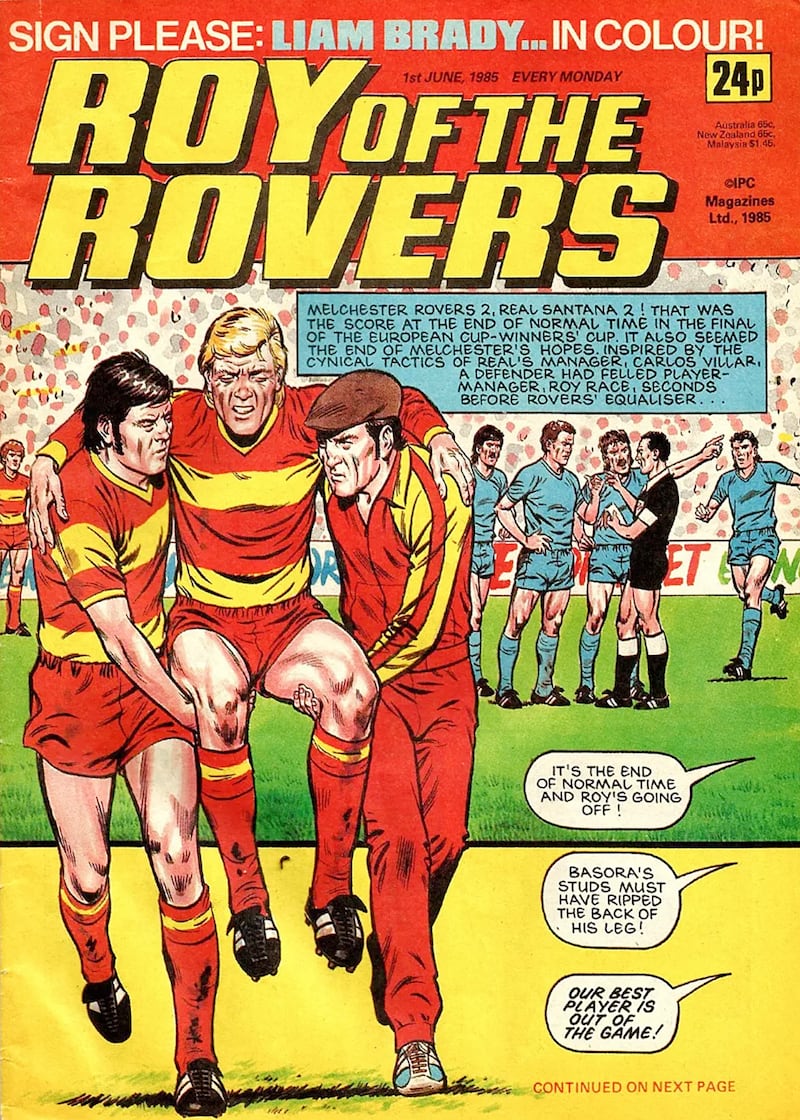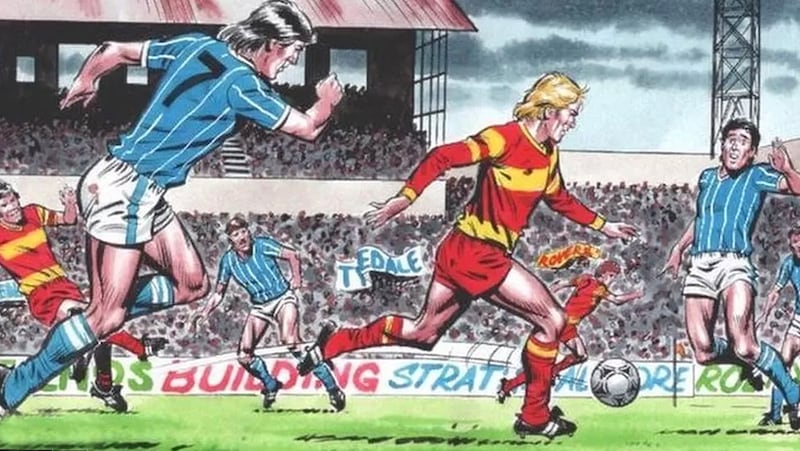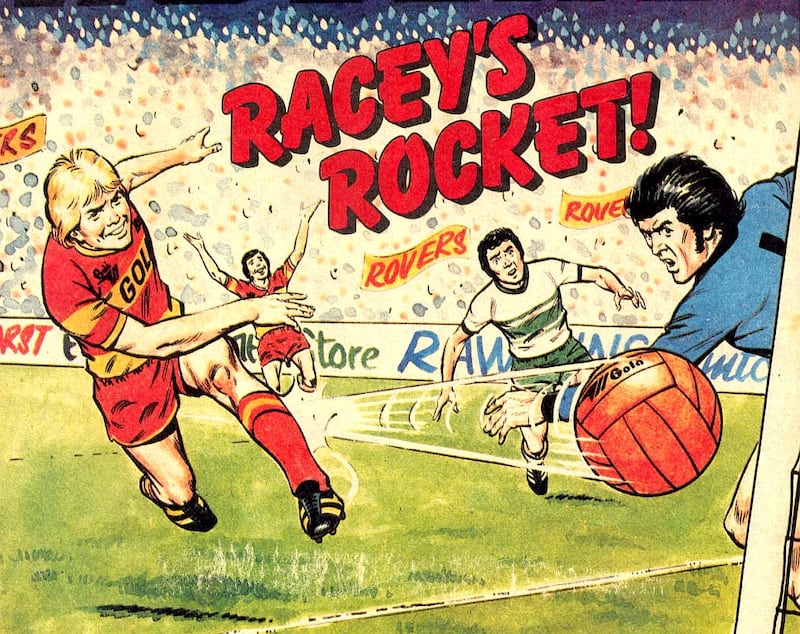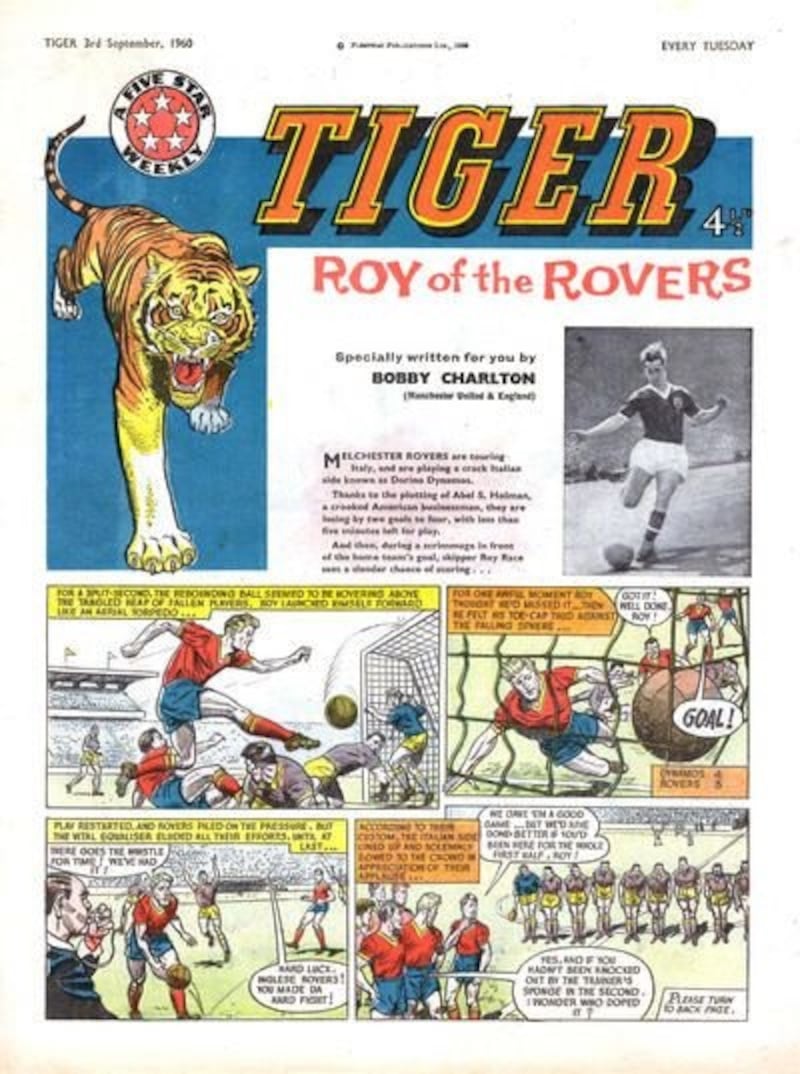Just over Barrie Tomlinson’s right shoulder, distinctive and unmistakable, a vivid red and yellow Melchester Rovers jersey is draped across a small wooden dresser.
You are instantaneously transported back to your youth while at the same time suddenly craving one of those suck-for-hours rhubarb and custard hard-boiled sweets which had the remarkable ability to both shatter your teeth and provide your total daily sugar intake.
The jersey is also a reminder that for the hundreds of times you produced a Racey’s Rocket down the back garden, you never managed to do it at a heaving Mel Park, netting an injury-time winner from the edge of the box against loathsome Melborough.
GOOAAAAAAAAAAAALL!!!
It reignites childhood memories of afternoons spent self-commentating on imaginary FA Cup finals, spinning away in celebration under a hail of rosettes, while Blackie Gray, Duncan McKay, Vic Guthrie, Vernon Eliot and Steve Wooten raced over to hoist you shoulder-high and provide a triumphant king’s chair off the pitch. Magic.
“It’s nice that people still remember Roy of the Rovers, it’s lovely that it played such a big part in their lives growing up,” smiles Tomlinson, the former editor of the iconic comic, prompting a timely end to your reverie.

The phrase “Roy of the Rovers stuff” has long since become part of the sports lexicon, a cliche reached for by fans, commentators and reporters alike to describe a moment of supreme, barely believable, skill. Life imitating art.
Roy, who was created by writer Frank Pepper and brought to life by artist Joe Colquhoun, first appeared in 1954 as a character in one of many stories in Tiger magazine.
However, the strip’s popularity led to it becoming its own weekly football-themed comic, which was launched in September 1976 and ran until March 1993. Over 800 issues were produced, with Tomlinson working as editor of the magazine from its launch until 1989. At its height it shifted more than 400,000 copies per week.
Roy of the Rovers was as intrinsic to popular culture in Britain (and consequently Ireland too) in the 1980s as Big Daddy and Giant Haystacks, or MacGyver or Knight Rider or CHiPs. If you read Roy of the Rovers then, chances are you could still hum the theme tune of BBC’s Grandstand now.
It’s almost quaint looking back at the stature this wholesome comic-book footballer enjoyed in everyday society – with his distinctive golden hair and angular jaw. And it’s certainly utterly bonkers that Roy’s exploits were regularly reported on in the UK’s national newspapers.
Tomlinson was keen to move away from a one-dimensional character who merely played football and scored great goals.

“Roy was the first boy’s comic book hero to get married,” recalls Tomlinson. “He became a father, and by doing that we started to get an enormous amount of publicity in the media.,National newspapers, radio and even TV carried the stories.
“Some of the biggest publicity came around the time Roy’s wife, Penny, left him because he was spending too much time at the football club.”
In a recent interview with Gary Lineker for BBC’s Football Focus, current Tottenham Hotspur manager Ange Postecoglou, when talking about where his love of the game started, namechecked Roy of the Rovers as one of the magazines he used to read growing up in Australia.
On the day Ireland made their inaugural World Cup appearance – against England in June 1990 – a song called Europe United was released, a tune essentially calling on fans not to cause trouble during Italia 90. It was a collaboration involving Lineker and Roy Race.
Ian Wright, Alan Smith, Luther Blissett, Trevor Francis and Tommy Docherty are among the many from the world of football who over the years posed alongside a giant cardboard cut-out of Roy.
It was a kid’s comic football strip that became a soap opera, and somewhere along the way the clean-living, free-scoring Roy Race transcended the pages of a magazine to become a cultural institution.
And yet misfortune seemed to stalk Roy around whenever he stepped off the pitch – in the early days every time he arrived in a South American airport he was greeted by kidnappers, earthquakes tended to follow him around the globe too, while the team bus was destroyed by a car bomb in the fictional country of Basran. Eight of Roy’s team-mates died.
Tomlinson admits certain plots and racial stereotypes would not be acceptable today.

“No, I don’t think we could use some of the situations or some of the characters.”
One of the standout storylines was the who-done-it assassination attempt on Roy. The attack left the star in a coma, fighting for his life.
OH, NO!
However, during that time Alf Ramsey agreed to step in as interim manager at Melchester Rovers and Roy eventually made a full recovery.
HURRAAAAAAAY!
England’s 1966 World Cup-winning manager was just one of many famous faces happy to appear as a character in the comic.
Two members of Spandau Ballet even joined Melchester Rovers as players at one stage, while Geoffrey Boycott was club chairman for a period.
“Whenever we approached a well-known personality and asked would they consider being involved, they would always do it free of charge,” remembers Tomlinson. “Nobody ever looked for money.
“I wrote to Sir Alf Ramsey asking if he would be in the story as manager while Roy was in hospital and he agreed. I then sent him the scripts and the artwork, expecting there to be some requests for changes, but he didn’t ask for any alterations at all.”
Still, deciding to call the new football-themed magazine Roy of the Rovers wasn’t as straightforward as one might think.
“Roy of the Rovers was going to be in the new comic but the question was what to call the new magazine. I suggested Roy of the Rovers, but they weren’t keen on the basis the title was too long.
“I pointed out that News of the World was the same number of words and eventually they agreed, so we called it Roy of the Rovers.”
The rest is comic book history.
Roy of the Rovers included several different strips – including The Safest Hands in Soccer, The Hard Man, Tommy’s Troubles, Millionaire Villa and Durrells Palace. Billy’s Boots would be added in later years, but Roy was the pre-eminent figure throughout.
Tom Tully succeeded Pepper as lead writer and was the man who crafted the vast majority of Roy’s career from the mid 70s until the early 90s. The 23rd floor offices overlooked the Thames from London’s Stamford Street, near Blackfriars Bridge.
“I’d meet with Tom once a month in my office,” says Tomlinson. “We’d go through all of the plots on and off the pitch, plan the storylines for the next month.
“Then we’d go out and have a very long and leisurely lunch, Tom smoking a cigar and finishing off with a brandy. We got a lot of very good ideas on those lunches.”
It was a small editorial team, usually of four – editor, subeditor, art editor and art assistant – with the writers and artists usually operating on a freelance basis as contributors.
Tomlinson introduced a hotline for readers to call with any messages they might have for Roy. On the first Sunday it was operational, he checked from home if anybody had bothered ringing.
“When I phoned the number to check, the tape was totally jammed. I had to rush to London to put a new tape on.”
Cassette tapes, remember those?
“This was before phone-in shows became popular and it turned out readers loved leaving their views or giving Roy a message.”
One of Tomlinson’s proudest decisions remains pivoting towards the development of a more authentic, rounded character.
“In the early days, Melchester Rovers tended to win every competition in which they played, the first episode might have them saying, ‘Let’s try win the FA Cup this year’. And you knew in the last instalment that’s exactly what they would do.
“I wanted to change that, make it more true to life, they once even got relegated. We tried to bring forward some of the secondary characters as well.
“And most notably we gave Roy a life outside of football, I think that was a good decision. He had a domestic life as well as a football life.”
“But there were certain things Roy wouldn’t do, he was a clean living sort of fella and it was always important to maintain that, there were boundaries he couldn’t cross.”
The comic spawned an array of spin-offs and merchandise, Melchester Rovers Subbuteo teams, Christmas annuals, a computer game and even a Roy of the Rovers chewy pineapple flavoured bar – which had such a freakishly yellow hue it might have doubled as a glow in the dark stick.

But with the growing popularity of computer games and rapid developments in the toy industry, comic sales started to fall sharply in the 1990s. Four years after Tomlinson had departed as group editor, Roy’s story came to an abrupt and ghastly end when he lost his famed left foot in a helicopter crash.
UU-UUUUUUUUGH!
“I think that was one of the greatest tragedies in the history of British comics,” says Tomlinson.
“I think the new people involved with the title at the time were looking to drum up some publicity but once you’ve chopped off the hero’s foot, what do you do? You can’t go back.
“You can have his wife leaving and them getting back together, that’s a story. But once his foot is gone, that’s it. I was very disappointed with that storyline.”
OOOOOF!
[ Subbuteo: Alive and flicking with the single greatest game ever inventedOpens in new window ]
Over the years there have been several relaunches and reboots, the most recent revival followed Roy as a teenager in the modern game trying to earn a trial at Melchester Rovers.
After Roy of the Rovers, Tomlinson produced a football strip in the Daily Mirror for 22 years – Scorer. He has checked out the various Roy revivals over the years and while pleased the name lives on, Tomlinson would have approached it differently.
“I’ve always thought of him as a real character, considered him a friend.”
He likes to imagine life turned out differently for Roy Race. In Tomlinson’s version, the helicopter crash never happened.
And these days Roy would still be with his beloved Melchester Rovers, either as an ageing manager or a hands-on director of football
“He’d be an Alex Ferguson-type character, still a powerful figure in the club,” suggest Tomlinson. “He’d certainly still be involved, there’s no way Roy could not be involved in football.”
He’d be sitting in the stand, flanked by Blackie Gray and Duncan McKay, smiling as his grandson netted an injury-time winner against Melborough. A wave of camera phones would go up, followed by a brief pause to check the moment wasn’t about to be ruined by VAR. And then Mel Park would erupt.
ROVERS, ROVERS, ROVERS!
Magic.












